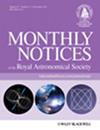Periodicity search in the timing of the 25 millisecond pulsars from the second data release of the European pulsar timing array
IF 4.8
3区 物理与天体物理
Q1 ASTRONOMY & ASTROPHYSICS
引用次数: 0
Abstract
In this work, we investigated the presence of strictly periodic, as well as quasi-periodic signals, in the timing of the 25 millisecond pulsars from the EPTA DR2 dataset. This is especially interesting in the context of the recent hints of a gravitational wave background in these data, and the necessary further study of red-noise timing processes, which are known to behave quasi-periodically in some normal pulsars. We used Bayesian timing models developed through the run_enterprise pipeline: a strict periodicity was modelled as the influence of a planetary companion on the pulsar, while a quasi-periodicity was represented as a Fourier-domain Gaussian process. We found that neither model would clearly improve the timing models of the 25 millisecond pulsars in this dataset. This implies that noise and parameter estimates are unlikely to be biased by the presence of a (quasi-)periodicity in the timing data. Nevertheless, the results for PSRs J1744−1134 and J1012+5307 suggest that the standard noise models for these pulsars may not be sufficient. We also measure upper limits for the projected masses of planetary companions around each of the 25 pulsars. The data of PSR J1909−3744 yielded the best mass limits, such that we constrained the 95-percentile to ∼2 × 10−4 M⊕ (roughly the mass of the dwarf planet Ceres) for orbital periods between 5 d–17 yr. These are the best pulsar planet mass limits to date.欧洲脉冲星定时阵列第二次数据发布中的 25 毫秒脉冲星定时周期性搜索
在这项工作中,我们研究了 EPTA DR2 数据集中 25 毫秒脉冲星定时中存在的严格周期性信号以及准周期性信号。鉴于最近在这些数据中发现了引力波背景的蛛丝马迹,以及进一步研究红噪定时过程的必要性,这一点尤其令人感兴趣,因为已知某些正常脉冲星的定时过程具有准周期性。我们使用了通过 run_enterprise 管道开发的贝叶斯定时模型:严格的周期性被模拟为行星伴星对脉冲星的影响,而准周期性被表示为傅里叶域高斯过程。我们发现这两种模型都不能明显改善该数据集中 25 毫秒脉冲星的定时模型。这意味着噪声和参数估计不太可能因为定时数据中存在(准)周期性而产生偏差。不过,PSRs J1744-1134 和 J1012+5307 的结果表明,这些脉冲星的标准噪声模型可能不够充分。我们还测量了 25 颗脉冲星周围行星伴星的预计质量上限。PSR J1909-3744 的数据产生了最好的质量限值,因此我们将轨道周期在 5 d-17 yr 之间的 95 百分位数限制为 ∼2 × 10-4 M⊕(大致相当于矮行星谷神星的质量)。
本文章由计算机程序翻译,如有差异,请以英文原文为准。
求助全文
约1分钟内获得全文
求助全文
来源期刊

Monthly Notices of the Royal Astronomical Society
ASTRONOMY & ASTROPHYSICS-
CiteScore
9.10
自引率
37.50%
发文量
3198
审稿时长
3 months
期刊介绍:
Monthly Notices of the Royal Astronomical Society is one of the world''s leading primary research journals in astronomy and astrophysics, as well as one of the longest established. It publishes the results of original research in positional and dynamical astronomy, astrophysics, radio astronomy, cosmology, space research and the design of astronomical instruments.
 求助内容:
求助内容: 应助结果提醒方式:
应助结果提醒方式:


